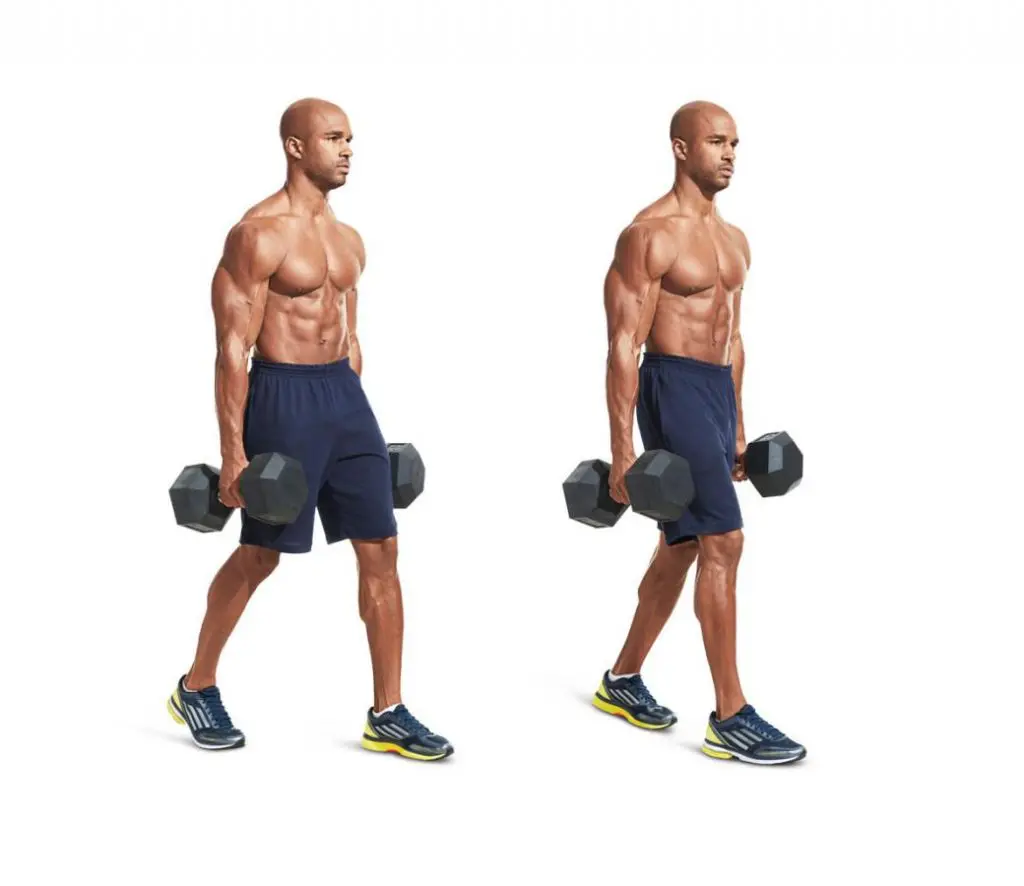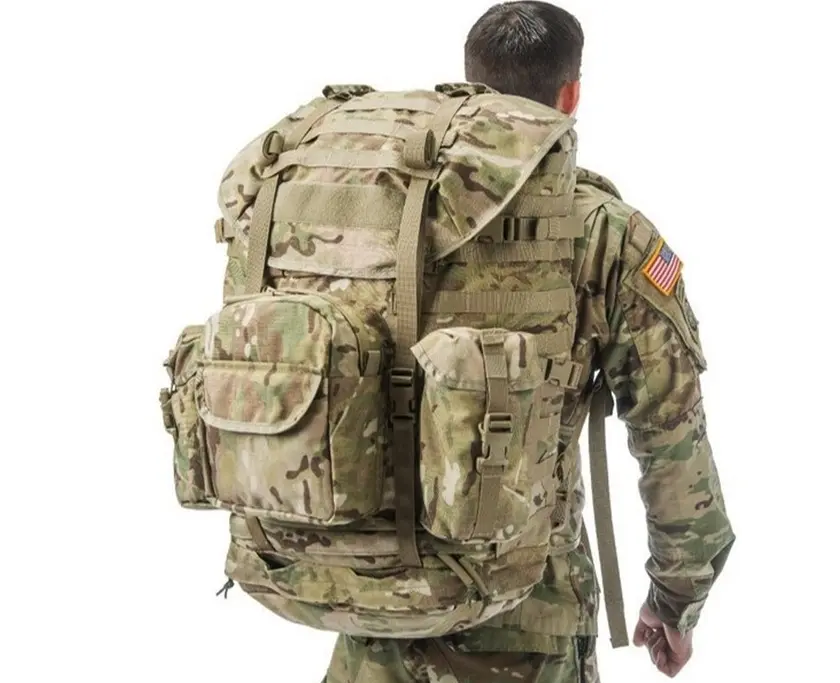Picking up and carrying heavy stuff is the ultimate test of all-round strength. That’s why loaded carries are such a big part of the World’s Strongest Man competition. Carrying heavy loads works your entire body. And if you have to carry a heavy object over long distances, it’ll challenge your heart and lungs too.
Because of this, almost everyone who lifts should include some form of loaded carries in their workouts. They’ll help you achieve nearly any fitness goal, from building muscle to getting strong to burning fat to boosting athletic performance. They also increase mental toughness.
Here are 10 of the best loaded carries for strength and size.
1. The Basic Farmer’s Walk
New to weighted carries? This is the place to start. The basic farmer’s walk is straightforward to learn and master, but it’s still a very effective exercise. Like all weighted carries, farmer’s walks are a full-body move, but most people feel it most in their forearms, traps, and core.

How to do it:
- Place two dumbbells on the floor, about shoulder-width apart, so the handles are parallel. Squat down and grab the dumbbells tightly. Straighten your arms, drop your hips, and deadlift the weights up. Keep your shoulder muscles and traps activated, brace your core, but keep your arms straight.
- Take a walk around your training area. Keep going until you feel your grip starting to fail.
- Lower the weights back to the floor and rest.
- This exercise can also be done using kettlebells, a trap bar (hex bar), or dedicated farmer’s walk handles
2. One-handed Farmer’s Walk
Carrying a weight on only one side means your core has to work much harder to keep your torso erect. You’ll really feel this exercise in your abs and obliques on the side opposite the load. Make sure you keep your spine vertical during this exercise, resisting the temptation to lean over toward the weight.
How to do it:
- Place a single dumbbell on the floor and then stand next to it. Squat down and grab it tightly, and then deadlift it up, so you are stood perfectly upright. Brace your core hard.
- Take a walk around your training area, continuing until you feel your grip starting to fail. Lower the weight to the floor, swap hands, and repeat.
- You can also do this exercise with a kettlebell or, for an even greater challenge, a barbell, although you’ll have to make sure you grip it precisely in the middle.
3. The Basic Waiter’s Walk
This exercise is so-called because, with your arms extended overhead, you’ll look a little like a waiter carrying a tray of food. Holding a weight in this position increases shoulder activation as you’ll have to work a lot harder to stabilize your arm. It’s also a good exercise for your upper traps.
Level Up Your Fitness: Join our 💪 strong community in Fitness Volt Newsletter. Get daily inspiration, expert-backed workouts, nutrition tips, the latest in strength sports, and the support you need to reach your goals. Subscribe for free!
How to do it:
- Clean and press two dumbbells or kettlebells overhead. Brace your core and activate your shoulders to keep the weights stable.
- Keeping your arms vertical, walk around your training area for the prescribed time or distance.
- Carefully lower the weights to your shoulders and then to the floor, rest, and repeat.
- This exercise can also be done using a barbell.
4. Single-arm Waiter’s Walk
As with the single-arm farmer’s walk, using just one arm for this exercise increases core activation. Do your best to keep your torso perfectly upright throughout.
How to do it:
5. Bottoms-up Kettlebell Weighted Carry
The more unstable an object is, the harder it is to carry. As the object wobbles, you’ll need to use your core and stabilizers to tame it and avoid dropping the load. This exercise is a tremendous weighted carry for shoulder and core stability. It also teaches you how to lock your shoulders into a very strong position, which will have a positive effect on almost all upper body movements and could even lower your risk of future shoulder joint injury.
How to do it:
- Clean and hold two kettlebells to shoulder-height, so the weight is upside down. Grip the handles as tightly as you can to keep the kettlebells from falling inward or outward. Flex your lats, pull your shoulders down and back, and brace your abs.
- Keeping the weights stable, walk around your training area for the prescribed time or distance.
- Increase core activation by doing this exercise with one kettlebell at a time.
- You can also press and hold the weight overhead to make it a bottoms-up single-arm waiter’s walk.
6. Zercher Carry
The Zercher position involves holding a weight in the crook of your arms. This requires good arm and upper back strength. You’ll also have to use your glutes and hamstrings more to keep your upper body upright as you walk.
How to do it:
- Rest and hold a barbell in the crook of your arms. Bend your elbows, so your hands are above the level of the bar to stop it rolling down your arms. If this is painful, wrap the bar in a towel or use a squat bar foam pad.
- Brace your abs and lift your chest. Keep your torso upright and shoulders down and back. Look straight ahead.
- Start walking and continue until you are no longer willing or able to continue.
7. Front Rack Barbell Carry
The front rack carry uses the same support position as front squats. If you have tight shoulders, forearms, or triceps, this position may be hard to get into and maintain. But, if you can do it, this weighted carry variation will provide your upper back with a great workout, as well as strengthening your core.
How to do it:
- Clean a barbell to your shoulders, and hold it across your front deltoids. Your upper arms should be close to parallel to the floor. If they aren’t, the bar will probably roll off your shoulders.
- Pull your shoulders down and back and brace your core.
- Without lowering your upper arms, walk around your training area.
- You can also do front rack carries using dumbbells, although two weights are harder to control than one.
8. Back Squat Weighted Carry
Of all the weighted carries, this one should allow you to lift the most weight. Ideally, for safety, you should do this exercise between two sets of squat racks, so you have a safe place to start and finish. Otherwise, you’ll need to clean and overhead press the weight to start, and then press and lower it to put the bar back down. This will be very challenging if you are carrying heavy loads, and especially at the end of your set when you’re tired.
How to do it:
- Rest and hold a barbell across your upper back. It should be on your upper traps and not on your neck. Your upper traps will keep the bar off the bony part of your spine, making the exercise safer and more comfortable.
- Grip the bar tightly, pulling it down onto your back, so it doesn’t move. Brace your core.
- Walk around your training area for the prescribed time or distance.
- You can also do this exercise using a sandbag or a dedicated yoke.
9. Bear Hug Carries
Barbells, dumbbells, and kettlebells are all great implements for weighted carries. However, on the downside, they are all easy to grip and hold. If you want to really challenge your body, try carrying something bigger, bulkier, and less evenly balanced. You’ll need to wrap your arms around your chosen implement and hold it to your chest in a fierce bear hug.
Level Up Your Fitness: Join our 💪 strong community in Fitness Volt Newsletter. Get daily inspiration, expert-backed workouts, nutrition tips, the latest in strength sports, and the support you need to reach your goals. Subscribe for free!
This will put extra pressure on your chest, making it harder to breathe. Good options for this exercise include sandbags, a couple of weight 45 lbs. plates, a loaded backpack, a water jug, big rocks, an old tire, a punchbag, or even your training partner!
How to do it:
- Pick up your chosen object and clutch it to your chest. Use the best technique you can, which will depend on the type of object you are lifting. However, try and avoid rounding your lower back.
- Overlap your arms to increase friction and strengthen your grip to make things a little easier or keep your hands apart to make it harder – your choice.
- Brace your abs and get walking. Keep going until you are unable to unwilling to continue.
10. Rucking
The nine weighted carries outlined above are good weight room exercises that are typically done for sets or time or distance. However, that’s not the only way to do weighted carries. If you want to develop your aerobic fitness and muscular endurance, try rucking.

Rucking is a military term that describes walking long distances while wearing a heavy pack. This will kick your heart and breathing up without having to break into a run. If you want to develop your fitness and burn fat but prefer to avoid the impact of running, this could be the exercise you need.
How to do it:
- Load up a backpack with some weights. You can use gym weight plates, sandbags, water bottles, books, or any other suitable ballast. Put your pack on, making sure nothing hard is poking you in the back. Start off with about 10-15% of your body weight and increase from there.
- Head out and walk briskly for as far or as long as you want. Take care not to go too far in one direction because you’ll have to walk back too.
- Keep your core braced throughout.
- Wear supportive shoes or boots to protect your ankles and feet and take care if you are rucking over rough terrain. Rucking downhill is harder on your knees than going uphill, although going uphill is much more intense.
- Use a weighted vest instead of a rucksack if preferred.
Variations for making weighted carries even more effective
If you are new to weighted carries, walking in a straight line will probably be challenging enough. But, if you are an experienced weight carrier, you’re probably ready for something a little more demanding. Here are a few variations that will kick your weighted carries up a notch.
Walk forward and then backward – if walking forward no longer presents much of a challenge, try making your return journey harder by walking backward. Make sure your path is clear of obstacles.
Zig-zag carries – weaving in and out of cones, poles, or something similar will increase core and stabilizer activation, especially with something like waiter’s walks. Changing direction will also increase hip and glute activation.
Figure-eight carries – short on space? No problem! Follow a figure-eight path to cover a longer distance within a confined training area. In addition, all those constant changes in direction will require more balance and stability.
Overs and unders – add an extra dimension to your weighted carry workouts by putting obstacles in your path. This could be something as simple as a low hurdle you need to step over, or a set of steps you need to climb. Or, you could make things really hard by having to duck under a barrier. Any changes in body alignment will make your chosen exercise much harder.
Try a weighted carry medley – combine several different weighted carries to make a medley. For example, using the same pair of dumbbells for all the exercises:
- Basic waiter’s walk – 20 yards
- Dumbbell Front rack walk – 20 yards
- Basic farmer’s walk – 20 yards
- Bear hug walk – 20 years (hug a single dumbbell to your chest)
Weighted carries for strength and size – wrapping up
Whatever you are training for, weighted carries will help you get there faster. Brutally basic but incredibly useful, you can use these primal exercises to get strong, build muscle, or torch fat. They’re also handy for increasing fitness, endurance, and work capacity. Above all, they’re FUN!
Don’t overthink weighted carries; just find something heavy, pick it up, and take it for a walk. Stop when you get tired, rest a moment, and repeat. Do weighted carries as finishers after your main workout or dedicate an entire training session to this awesome workout method. However you use them, you’ll love the results.








